Every time I plant brassicas, I do so with a mix of excitement and dread – while I am looking forward to harvesting the heads and leaves, I know that voracious and destructive green caterpillars are also going to enjoy this crop.
Be prepared with some organic controls for Cabbage White Butterfly (Pieris rapae), so that when they inevitably arrive you are ready to take action!
If you are out in the garden most days, it can be simple enough to just pick off the grubs as you see them. Keep in mind that they can start being destructive even while very small. But the sheer numbers of caterpillars appearing may lead you to use both preventative methods and sprays to control them.
However, if the sheer numbers of caterpillars appearing becomes overwhelming – then consider these organic methods to control them.
First Things First – Identification
It is important to know what you are dealing with. The adult Cabbage White Butterfly is a small white butterfly with black spots on the wings. They hover and dip over the plants in the garden as they fly around, which means they are either seeking an egg laying position (females), or looking for a mate (males).
It is the caterpillars emerging from the eggs laid on the underside of the leaves that cause the damage. They strongly prefer the brassica or cruciferous vegetables – cabbage, kale, broccoli, cauliflower, etc. – so must be something about the mustard oils that they need.
The caterpillars are smooth and a dark greyish green colour, but can also have variations of brown and grey. When older they can have a distinct yellow line down their back.
They can be hard to find, but if you have holes in the leaves and tell tale droppings – then look under the leaves and in the centre of the plant.
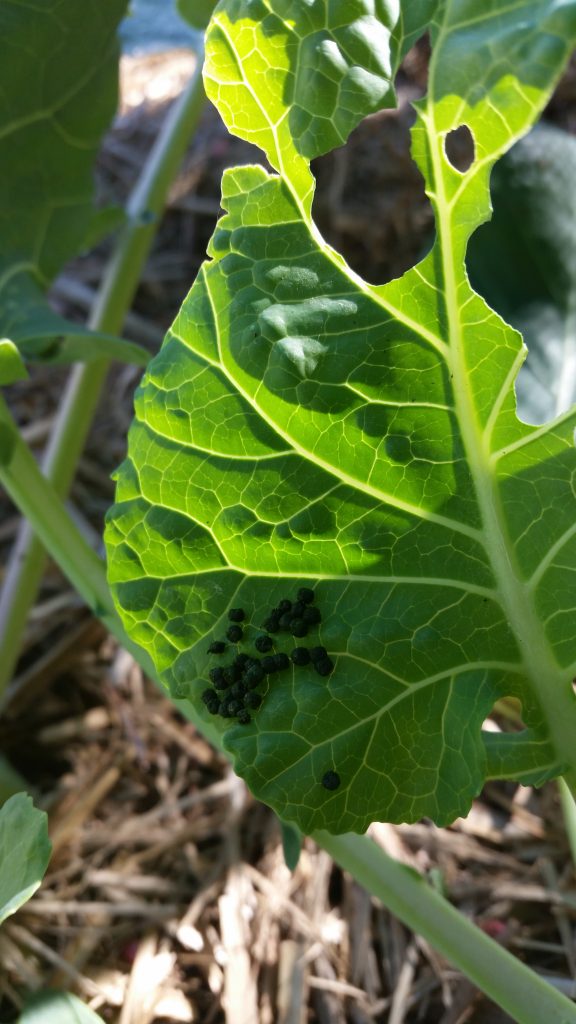
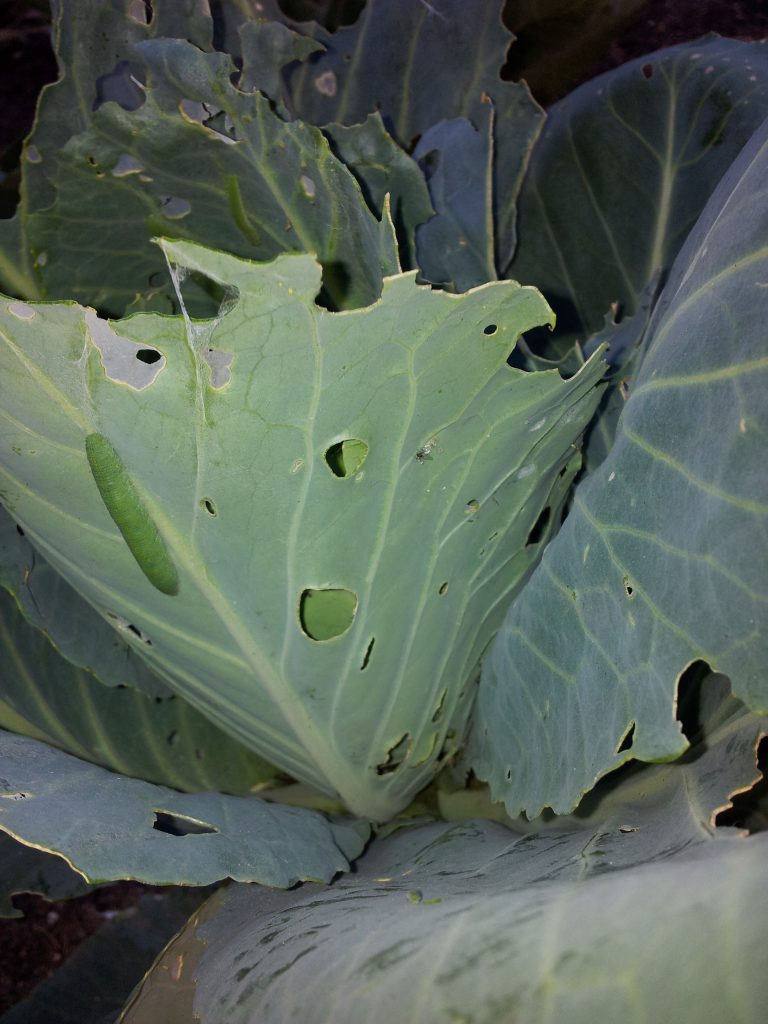
Preventative Methods
The goal here is to stop the butterflies from laying their eggs in the first place, either by discouraging them from landing – or by physically preventing them from accessing the leaves.
Mess With Their Tiny Little Minds – Decoys
The cabbage white butterfly is reputed to be territorial, meaning that it will seek out an area to lay eggs away from their comrades, this makes sense in terms of them wanting their offspring to have a food source with little competition. I keep hearing about using decoys to trick the butterflies into thinking that your patch is already occupied, techniques such as
- tying strips of plastic to string, so it flutters
- leaving largish segments of eggshells lying about
- cutting white plastic into butterfly shapes, and placing on bamboo stakes
Does This Work?
I am not entirely sure, and here is why. I have tried the string lines of white plastic bows method – and I can’t say that the cabbage white butterflies seemed to avoid the garden.
Overall I am not convinced about the decoy method. I’ve seen plenty of Cabbage Whites fluttering about the Broad Bean patch, and Broad Bean flowers look a lot like Cabbage Whites. They have white flowers with black spots, and I would think that if the butterflies were that concerned about look-alikes they would clear out!
That is no scientific argument by the way, so if you think decoys are working in your garden please let me know.
Don’t Let Them In – Physical Barriers
By using a mesh, the butterflies can be prevented from landing on the leaves and laying the eggs. This can be achieved either by using a netting fabric, or metal enclosures.
The challenge is to cover each plant, if you know you need this solution at the start, then it is fairly simple to plant a row that is designed for a tunnel covering. There are also some excellent frame and netting systems available for purchase.
If you have your brassica plants dotted around the patch then each needs to be covered individually. I have started using paper bins for small seedlings, just remember to remove them often to check on the plant’s health.
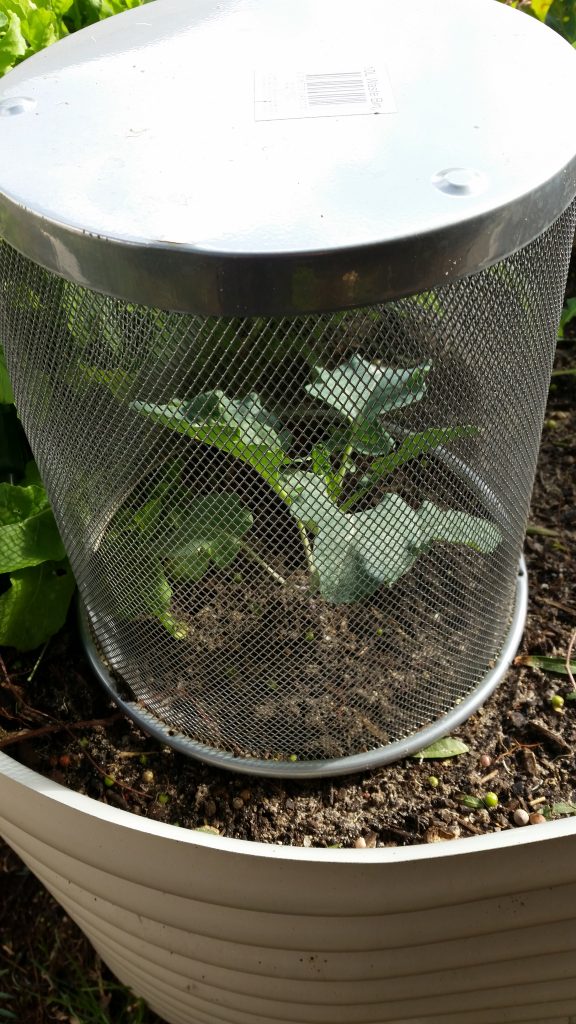
DIY Options
Curtain netting is inexpensive, and the nylon fabrics hold up well in wet weather. Also, the discount/variety shops often have products such as pop-up laundry hampers and food covers that can make effective screens – just look for a fine mesh.
Sprays
There are two organically acceptable sprays available, the Bacillus thuringiensis (also known as bt) type sold under the brand Dipel, and a spinetoram type sold under the brand Success.
I prefer Success as it is faster acting, and holds up well when it rains.
Remember to spray under the leaves and over the stems – the spray is only effective when the leaves are covered.
** Always read the label before using, follow the mixing instructions, discard any unused sprays and clean your spraying equipment thoroughly, and use the recommended personal protective equipment **
Bee Careful
If using sprays, please spray either early in the morning or late in the afternoon when bees are not feeding on flowering plants.
Natural Control Methods
The caterpillars can be parasitised by a wasp, with the young emerging soon after. If you see a caterpillar grub surrounded by tiny yellow cocoons wrapped in a webbing – this is a sign that the wasps have already emerged from the caterpillar and moved on to their next stage of development.
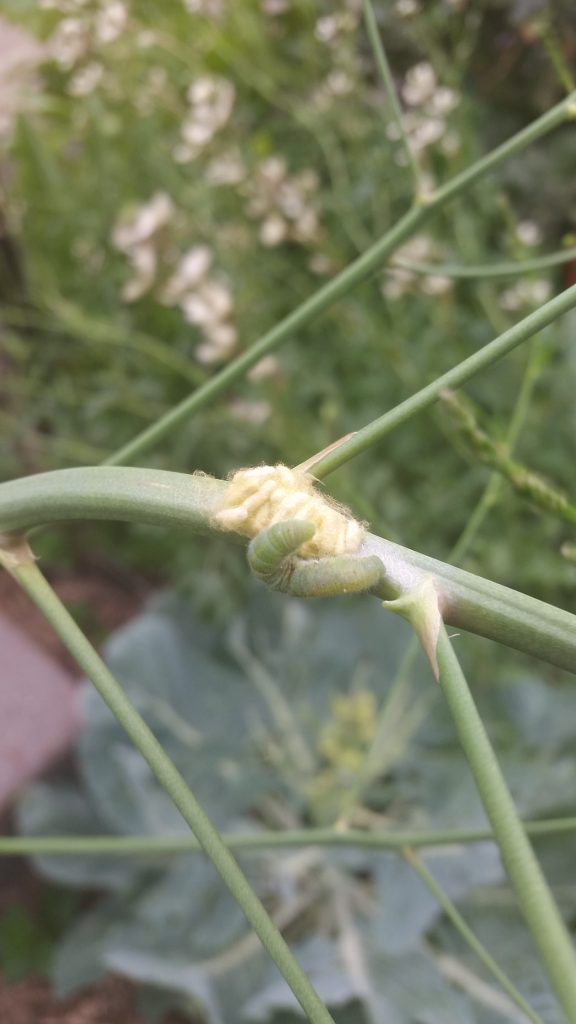
Gross But Effective – How Wasps Use Caterpillars
The female wasps lay their eggs into the caterpillars, which is still living, as they hatch and mature the wasp larvae bore out of the caterpillar and spin yellow silk cocoons around themselves. The host caterpillar attached to this cluster of yellow cocoons slowly dies.
Wasps emerge from these cocoons and the cycle continues.
If you are able to remove a few caterpillars by hand, and leave the rest to the wasps – then you can easily manage this pest without introducing sprays. You may not be able to do this in a single season, building a healthy organic garden with a population of beneficial insects takes time. It is important to have many varieties of flowering plants throughout the year to support insects like wasps.
Do you have a lot of green caterpillars in your vegetable garden? What are your best organic controls for Cabbage White Butterfly?
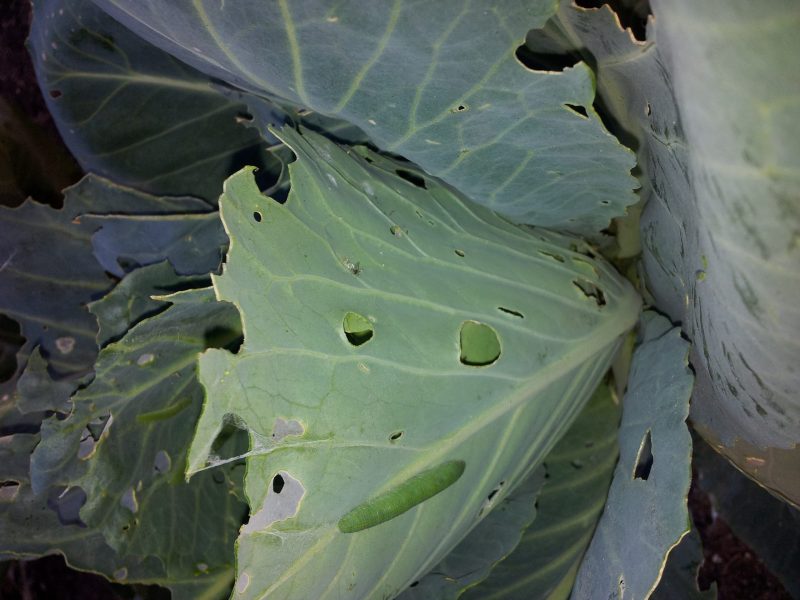

5 replies to "Organic Controls For Cabbage White Butterfly"
This is my first year trying to grow purple sprouting ( or any brassica ) . Where I grew broad beans close by I only found one group of yellow cabbage white eggs which I destroyed . Where I attempted to grow peas ( very poor germination ) and carrots I had many eggs laid on virtually all the plants and destroyed most , unfortunately not all !
So , I am assuming that the broad beans inhibited the butterflies . The two beds were only five yards apart , and the second group were netted too , though not very well.
Hi Alice, I came across an easy way to deter the cabbage white butterflies from my kale. I used some bubble wrap as a windbreak around a large pot of kale seedlings and they have grown successfully even with the white butterflies present in my garden. The bubble wrap seems to deter the butterflies and my kale has grown without holes for the first time ever.
I had two gardens, one for veggies and the other for various flowers (mainly annuals). Due changed circumstances I did not require the usual Veggies and planted flowers with the odd brassica intermingled with the flowers (other veggies were also grown very successfully among the flowers).
I just left all plants to do there own thing, Insect and other sprays were not used. As usual the white butterfly constantly circled the garden searching for the cabbages, cauliflower and broccoli. Only one was found.when the cabbages, cauliflowers and broccoli were ready to harvest it was discovered that all cabbages and cauliflowers et cetera were absolutely clean, there were no blemishes and there was no evidence of damage by white butterfly. From now onwards I will grow my vegetables amongst flower gardens.
I mentioned (above) that at one cabbage was found to have been attacked by white butterfly, it was growing at the edge of the garden and the white butterfly was able to lay its eggs. Because I would had not sprayed for any White butterfly or other predators the insect life amongst the plants was amazing. Because of that huge numbers of insects the birdlife was also amazing. And the birds discovered this one cabbage had been attacked by white butterfly and the birds made a feast the lavey.
I’d be interested to know if other gardeners grow vegetables amongst flowers (conversely flowers among vegetables). If so, what have the results been.
Maybe a commercial grower of cabbages and cauliflowers could consider planting the plants in rows which are a little wider apart and in between each row planting different types of flowers as a deterrent to white butterfly. There may be the opportunity to also have a second cash-flow benefit of selling flowers as well as cabbages, cauliflowers, brussels sprouts and broccoli.
You may publish this e-mail if you wish.
Hello, thank you for the great advice, I’ve been reluctant to plant out my brassicas due to the white butterflies fluttering around but now have a few tricks to try. Vernon Eugene Aynsley, I am curious as to what flowers you planted amongst your brassicas – wondering if some may deter more than others (colour/size/smell – the predators the flowers are likely to attract…). I also have a question about the eggs – I recently picked some off my kale seedlings, however, some fell into the seed raising mix the seedlings were planted in and I could not find them (so tiny)! Does anyone know if they will still hatch if not on the leaf?
Tracy, the caterpillars will hatch but likely starve to death before reaching a meal unless they dropped right next to a leaf of kale, etc. That is why the mom lays the eggs right on top the food. If you put down some nice mulch, omw! can you imagine what that must look like to a tiny caterpillar? I once saw the Smoky Mountain Range & I think that is the scale
of the barrier they would have to overcome to reach your plants from the soil.
As for what flowers to use: I employed a method similar to Vernon’s to discourage pests. I divided the bed into square feet, then put something different in each square. I planted a chaotic mix of onions, herbs, vegetables, flowers, etc. All around the border I planted onion sets & bulbs for extra insurance. I made sure that adjacent squares had a different plant types, but that was it. I made four 6 x 4 foot beds in this way. That was one of the easiest seasons I ever had. At the end of the season, I mixed in a 5-gallon bucket of compost then mixed the top 6 inches all up to prevent an insect buildup. Mostly because I can’t be bothered to make sure something different is planted in each square next season! (#lazy gardener)
What kinds of flowers? Any kind you like! Strong scent, open flowers, & umbrella-type flowers are good traits to look for. My good-guy insects liked tagetes, pot marigold, zinnia, violas, white-flowered yarrow… I can’t remember any others.
Veggies were carrots, bush beans, broccoli, cabbage, bush tomatoes, other smaller ones.
Herbs? Yes! I put in some of each. The mint died, but cilantro, basil, thyme, garlic chives, a small rosemary, bee balm, sage, & parsley all did well.
Use whatever does well in your area. If you really want to help out the predators let a spot near your garden go “wild”, put up some “houses” (Mason bee, butterfly, bat, bird, etc), never use sprays on pests (even soapy water can be harmful), and learn to love variety!
P.S. I also used a 6-inch layer of tree trimmings mulch to discourage ground-dwelling pests. Smaller plants got less until they grew up, or got a collar. Tree trimmings come from landscape companies. They will usually deliver the lovely mulch for free. The best parts? 1. Free 2. Has leaves chopped up in it which feed earthworms 3. They deliver 4. Encourages healthy plants that will repel pests, including moth larvae 5. Keeps the soil cool to keep the earthworms happy (their poop is the best fertilizer) 6. If you gather up some of that lovely poo & make it into a liquid to spray your leaves, it feeds plants & makes them taste terrible to moths (& other pests) but won’t hurt bees, etc. 7. It helps reduce greenhouse gasses by keeping the carbon in the soil where it belongs 8. It is recycling at it’s best! Every truckload you recieve is one less in a landfill.
Good Luck & Have Fun!